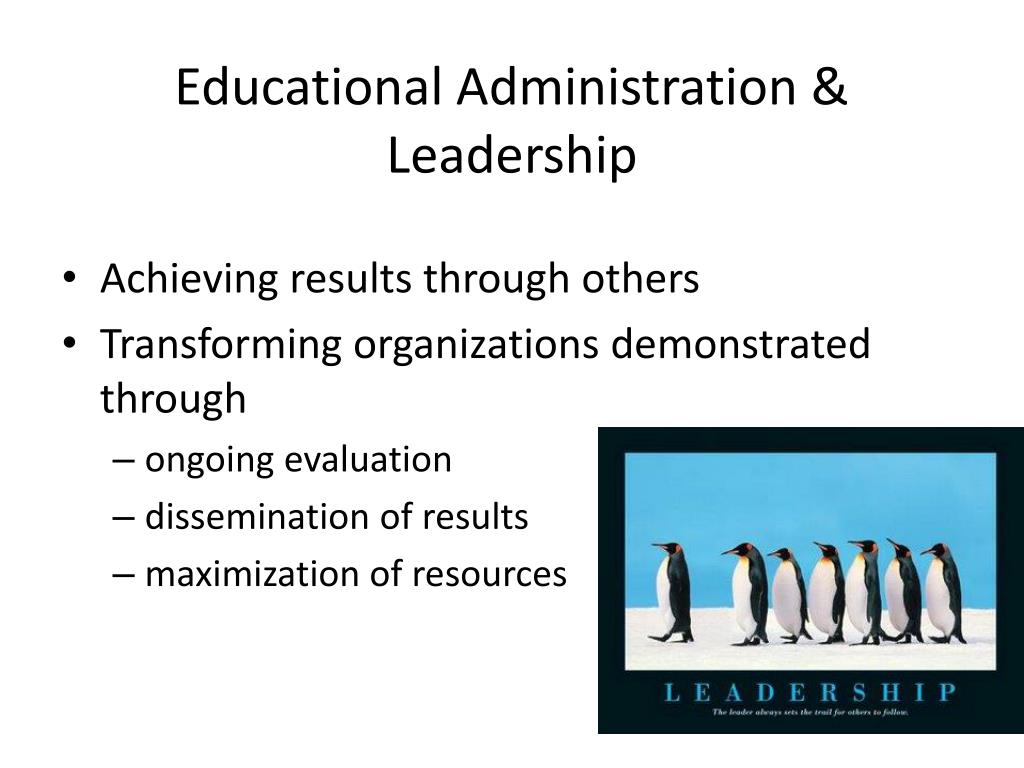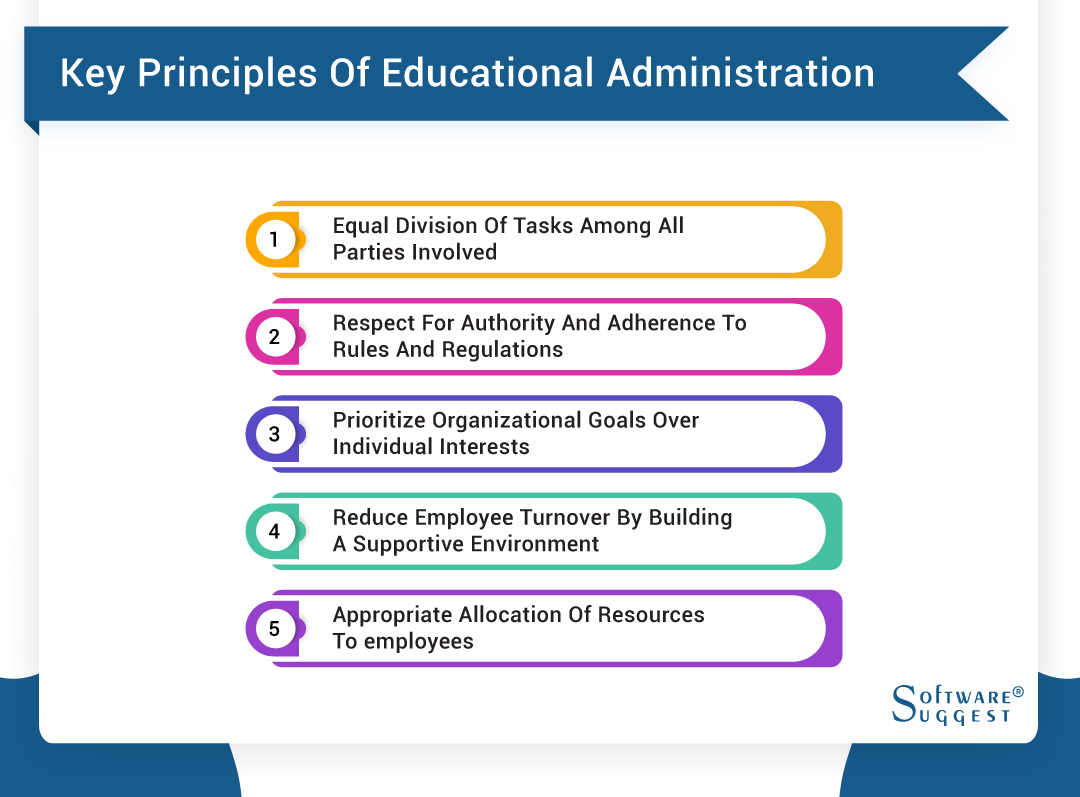Educational management administration and leadership is a fascinating field that encompasses the intricate interplay of management, administration, and leadership within educational institutions. This comprehensive guide delves into the key concepts, theories, and practices that shape this dynamic realm, providing valuable insights for aspiring and current educational leaders.
From understanding the historical evolution of educational management to exploring emerging trends and future directions, this guide offers a thorough examination of the field. It empowers readers with the knowledge and skills necessary to navigate the complexities of educational management, effectively lead teams, and drive positive change within educational systems.
Educational Management Administration and Leadership

Educational management, administration, and leadership are crucial components of the education system. These fields encompass the planning, organizing, directing, and controlling of educational institutions to ensure the effective and efficient delivery of education.
Historically, educational management has evolved from a focus on administrative tasks to a more comprehensive approach that emphasizes leadership and strategic planning. Today, educational managers, administrators, and leaders play vital roles in shaping the educational landscape.
Key Concepts
- Educational Management:The process of planning, organizing, directing, and controlling the resources and activities of an educational institution.
- Educational Administration:The implementation of educational policies and programs within an educational institution.
- Educational Leadership:The ability to inspire, motivate, and guide others to achieve educational goals.
Roles and Responsibilities
Educational managers, administrators, and leaders have distinct roles and responsibilities within the education system. Educational managers are responsible for the overall operation of an educational institution, including budget management, personnel management, and facilities maintenance.
Educational administrators are responsible for implementing educational policies and programs. They work closely with teachers and other staff to ensure that students receive a high-quality education.
Educational leaders are responsible for inspiring and motivating others to achieve educational goals. They create a vision for the future of education and work to bring that vision to reality.
Theories and Frameworks in Educational Management

Educational management involves the application of various theories and frameworks to enhance the effectiveness and efficiency of educational institutions. These theories provide a structured approach to understanding and addressing the complex challenges faced in educational settings.
Educational management administration and leadership is a complex field that requires a wide range of skills and knowledge. One important aspect of leadership is the ability to inspire and motivate others. Inspirational leadership speakers can be a great resource for educational leaders who are looking to develop their skills in this area.
These speakers can provide insights into the latest leadership theories and best practices, and they can also share stories and examples of how they have used inspirational leadership to achieve success. By attending inspirational leadership speaking events, educational leaders can learn how to create a more positive and productive work environment, and they can also develop the skills they need to inspire and motivate their students.
Systems Theory
Systems theory views an educational institution as an interconnected system of components that interact and influence each other. This theory emphasizes the importance of understanding the relationships between different parts of the system, such as students, teachers, administrators, and the community.
By analyzing the interactions and feedback loops within the system, educators can identify areas for improvement and make informed decisions.
Contingency Theory
Contingency theory suggests that there is no one-size-fits-all approach to educational management. Instead, the most effective management style depends on the specific context and situation. This theory encourages educators to consider factors such as the school’s culture, student population, and available resources when making decisions.
By adapting their approach to the unique circumstances, they can increase the likelihood of success.
Transformational Leadership
Transformational leadership is a style of leadership that inspires and motivates individuals to perform beyond expectations. Transformational leaders create a vision for the future and empower their followers to work towards achieving it. In educational settings, transformational leaders can foster a positive and supportive environment that encourages innovation, collaboration, and continuous improvement.
Emerging Trends and Future Directions, Educational management administration and leadership
The field of educational management is constantly evolving, with new theories and frameworks emerging to address the changing needs of the 21st-century learner. Some of the emerging trends include:
Data-driven decision-making
Using data to inform educational practices and improve student outcomes.
Personalized learning
Tailoring instruction to meet the individual needs of each student.
Technology integration
Leveraging technology to enhance teaching and learning experiences.
Equity and inclusion
Creating educational environments that are accessible and supportive for all students.By staying abreast of these trends and future directions, educational leaders can ensure that their institutions remain innovative and effective in meeting the challenges of the future.
Strategic Planning and Decision-Making in Education

Strategic planning is a systematic process that helps educational institutions establish a clear vision, set goals, and develop action plans to achieve their objectives. It involves assessing the institution’s current situation, identifying its strengths and weaknesses, and developing strategies to address its challenges and opportunities.
Needs Assessment
Conducting a thorough needs assessment is crucial for identifying the areas where the institution needs to improve. This involves gathering data from various sources, such as surveys, interviews, and data analysis, to determine the needs of students, staff, and the community.
Goal Setting
Based on the needs assessment, the institution should establish clear and measurable goals. These goals should be aligned with the institution’s mission and vision and should be specific, achievable, relevant, and time-bound (SMART).
Action Planning
Developing action plans is the next step in the strategic planning process. These plans Artikel the specific steps that will be taken to achieve the institution’s goals. They should include timelines, responsibilities, and resource allocations.
Educational management administration and leadership involve guiding and managing educational institutions. If you’re considering a PhD in leadership, you may wonder if it’s worth it. Check out this article: is a phd in leadership worth it to learn more. The insights provided can help you make an informed decision about pursuing a PhD and enhance your skills in educational management administration and leadership.
Decision-Making Models
Educational leaders use various decision-making models to make informed decisions. These models provide a framework for analyzing information, considering alternatives, and selecting the best course of action. Some common decision-making models include the rational model, the political model, and the intuitive model.
Human Resource Management in Education

Human resource management (HRM) plays a critical role in the success of any educational organization. It involves the planning, recruitment, selection, performance management, and professional development of educational personnel to ensure that the organization has the skilled and motivated workforce it needs to achieve its goals.
Effective HRM practices are essential for attracting and retaining high-quality teachers and staff, creating a positive and productive work environment, and ensuring that the organization is compliant with all applicable laws and regulations.
Recruitment and Selection
The recruitment and selection process is the first step in building a strong and effective workforce. It involves identifying and attracting potential candidates who have the skills and qualifications necessary to meet the organization’s needs.
There are a variety of recruitment methods that can be used, such as advertising, networking, and referrals. Once potential candidates have been identified, they will be screened and interviewed to determine their suitability for the position.
Performance Management
Performance management is an ongoing process that involves setting goals, providing feedback, and evaluating performance. It is essential for ensuring that employees are meeting the organization’s expectations and are developing their skills and knowledge.
There are a variety of performance management systems that can be used, such as the traditional annual review system or a more continuous feedback system. The system that is used should be tailored to the organization’s specific needs and culture.
Professional Development
Professional development is essential for helping employees to stay up-to-date on the latest trends and developments in their field. It can also help employees to develop new skills and knowledge that will make them more valuable to the organization.
There are a variety of professional development opportunities available, such as workshops, conferences, and online courses. The organization should provide employees with the support and resources they need to pursue professional development opportunities.
Unions and Collective Bargaining
Unions are organizations that represent the interests of employees in the workplace. They can negotiate with employers on behalf of employees to improve wages, benefits, and working conditions.
Collective bargaining is the process by which unions and employers negotiate a contract that Artikels the terms and conditions of employment. The contract covers a variety of issues, such as wages, benefits, hours of work, and grievance procedures.
Financial Management in Education

Financial management is crucial for educational institutions to ensure the effective and efficient use of financial resources. It involves planning, organizing, directing, and controlling financial activities to achieve educational goals.The principles of financial management in education include:
Transparency
Financial information should be accessible and understandable to all stakeholders.
Accountability
Educational institutions should be held accountable for their financial decisions and outcomes.
Efficiency
Financial resources should be used in a manner that maximizes educational outcomes.
Effectiveness
Financial management practices should contribute to the achievement of educational goals.
Budgeting
Budgeting is the process of allocating financial resources to various activities and programs. It involves:
Estimating revenue
Educational institutions must forecast their income from various sources, such as tuition fees, government grants, and donations.
Prioritizing expenses
Expenses should be classified and prioritized based on their importance to the educational mission.
Balancing revenue and expenses
The budget should ensure that revenue covers expenses, leaving a surplus for future investments or unexpected costs.
Educational management administration and leadership are essential for running schools and other educational institutions effectively. If you’re interested in a career in this field, you may want to consider pursuing a masters in sports leadership. This degree will provide you with the skills and knowledge you need to lead and manage sports organizations and programs.
You’ll learn about topics such as sports management, finance, marketing, and human resources. With a masters in sports leadership, you’ll be prepared for a variety of roles in the sports industry, including athletic director, sports agent, or coach. Once you have gained experience in the field, you may consider transitioning back to educational management administration and leadership, bringing your expertise in sports leadership to enhance the management of educational institutions.
Resource Allocation
Resource allocation involves distributing financial resources among different departments, programs, and activities. It considers factors such as:
Student enrollment
Resources should be allocated based on the number of students enrolled in each program.
Educational goals
Resources should be prioritized to support programs that align with the institution’s educational mission.
Cost-effectiveness
Resources should be allocated to programs that provide the greatest educational outcomes for the lowest cost.
Cost-Effectiveness Analysis
Cost-effectiveness analysis (CEA) is a technique used to compare the costs and outcomes of different educational programs or interventions. It helps decision-makers determine which programs provide the best value for money.CEA involves:
Identifying costs
All costs associated with the program, including direct and indirect costs, should be identified.
Measuring outcomes
Educational outcomes, such as student achievement, graduation rates, and job placement, should be measured.
Calculating cost-effectiveness
The cost-effectiveness ratio is calculated by dividing the total cost by the total outcomes. Programs with lower cost-effectiveness ratios are considered more cost-effective.
Funding Sources
Educational institutions receive funding from various sources, including:
Government grants
Governments provide funding to support public education at all levels.
Tuition fees
Students pay tuition fees to cover the costs of their education.
Donations
Individuals, corporations, and foundations donate funds to support educational institutions.
Impact of Financial Constraints
Financial constraints can significantly impact educational decision-making. When resources are limited, educational institutions may need to:
Reduce expenses
Institutions may need to cut programs, lay off staff, or reduce salaries.
Increase revenue
Institutions may explore ways to increase tuition fees, attract more students, or secure additional funding sources.
Prioritize spending
Institutions may need to prioritize spending on essential programs and services.Effective financial management is essential for educational institutions to achieve their educational goals and provide quality education to students. By adhering to sound financial principles and implementing effective financial management practices, educational institutions can ensure the optimal use of financial resources and maximize educational outcomes.
Final Wrap-Up

In conclusion, educational management administration and leadership is a multifaceted discipline that requires a deep understanding of educational principles, management techniques, and leadership strategies. By embracing the insights and best practices Artikeld in this guide, educational leaders can create dynamic and effective learning environments that foster student success and contribute to the overall well-being of our communities.
FAQ Resource: Educational Management Administration And Leadership
What are the key roles and responsibilities of educational managers?
Educational managers oversee the day-to-day operations of educational institutions, including planning, budgeting, staffing, and ensuring compliance with regulations.
How can educational leaders promote ethical decision-making?
Educational leaders can promote ethical decision-making by establishing clear ethical guidelines, fostering open communication, and encouraging stakeholder involvement.
What are the emerging trends in educational management?
Emerging trends in educational management include the use of data analytics, personalized learning, and technology integration to improve student outcomes.

